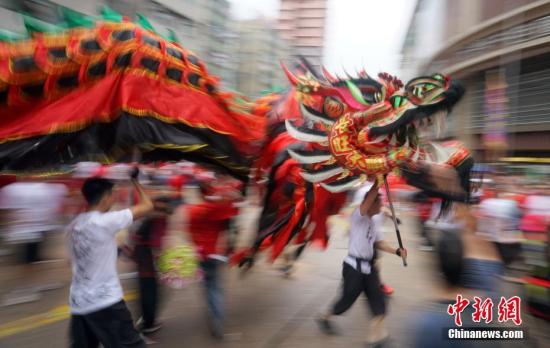China News Service, Hong Kong, June 18-The Leisure and Cultural Services Department (LCSD) of the Hong Kong Special Administrative Region Government announced on the 18th that the two intangible cultural heritage items in Hong Kong, the Tin Hau Birthday and Chinese gown making skills, were successfully included in the first published by the State Council. Five batches of "List of Representative Items of National Intangible Cultural Heritage" ("List").
Data map: The Tin Hau Birthday Parade held in Yuen Long, Hong Kong.
The picture shows the dragon dance performance.
Photo by China News Agency reporter Zhang Wei
A spokesperson for the Leisure and Cultural Services Department said that the two projects successfully declared this time cover the categories of "social practices, rituals, festivals" and "traditional handicrafts" defined by the United Nations Educational, Scientific and Cultural Organization’s Convention for the Protection of the Intangible Cultural Heritage. It has outstanding historical and cultural value, and is quite representative in the community or related categories.
Tin Hau Birthday and Chinese gown making skills were included in the "Hong Kong First Intangible Cultural Heritage List" and "Hong Kong Intangible Cultural Heritage Representative List" in 2014 and 2017 respectively.
The Tin Hau faith has a long history in Hong Kong.
According to legend, in the Southern Song Dynasty, there was a Tin Hau Temple at the Fotang Gate of Saigon.
Every year on the 23rd day of the lunar calendar or on other selected days, various communities in Hong Kong will hold celebrations of different scales. Some local groups will organize activities such as Cantonese opera magic operas and fireworks to reward the gods, and even hold sea activities. Or cruising on land.
Chinese gown making skills have a long history.
After the Second World War, a large number of Shanghai tailors came to Hong Kong to enrich the local gown production craftsmanship and integrate Western cutting methods to form Hong Kong's unique gown production skills.
Chinese gowns in Hong Kong used to be women's everyday clothes, but now they have become elegant clothes for important occasions.
In the tradition of the New Territories, the men's long gown is a status symbol for the elders of the clan and has important social significance. It is also a formal dress for attending grand occasions such as the Second Spring and Autumn Festival of the Clan and large-scale community celebrations including Taiping Qingjiao.
It is reported that the State Council respectively announced four batches of 1372 national intangible cultural heritage for inclusion in the "List" in 2006, 2008, 2011 and 2014.
The three governments of Guangdong, Hong Kong and Macao successfully listed Cantonese opera and herbal tea in the first batch of "List"; 4 projects in Hong Kong were successfully included in the third batch of "List" announced in 2011, including Cheung Chau Taiping Qingjiao and Tai O Dragon Boat Festival Dragon Boat Tour, Tai Hang Fire Dragon Dance and Hong Kong Chaozhou Yulan Shenghui; Hong Kong also has 4 projects successfully included in the fourth batch of "List" announced in 2014, including Sai Kung Hang Hau Hakka Unicorn Dance, Wong Tai Sin Belief, and All Zhendaotang ceremonial music and guqin art.
(Finish)

